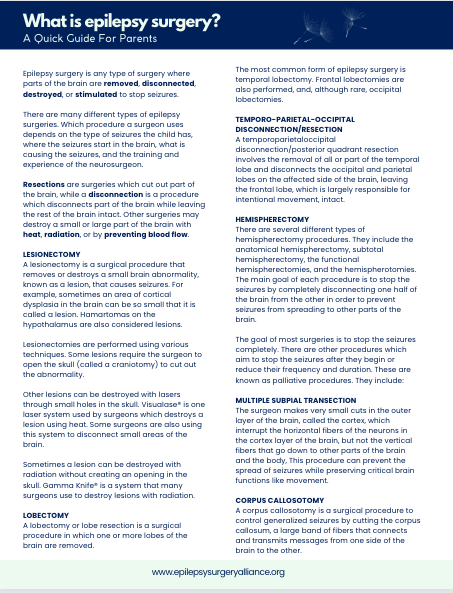What you need to know
What is pediatric epilepsy surgery?
Surgery for epilepsy is when the surgeon removes, disconnects, ablates, or stimulates a part of the brain to stop or slow down seizures.
There are many different types of epilepsy surgeries. They can be performed alone or combined.
Resection
Surgeries that remove part of the brain where the seizures start. Surgeons will use different types of techniques for this surgery, depending on how much of the brain is involved.
Disconnection
Surgeries that disconnect brain fibers such as corpus callosotomy or hemispherotomy. This stops seizures from traveling from where the seizures start to the rest of the brain.
Ablation
Surgeries that destroy the parts of the brain where seizures start. The most common surgery is laser ablation.
Neurostimulation
These are surgeries that stimulate a part of the brain to slow down or stop the seizures with special devices. These devices are sometimes called neuromodulation. The surgeon will implant a special device in the skull, neck, or chest. The device stimulates the brain with very low electrical currents.
Minimally invasive surgery
Some surgeries are minimally invasive. Minimally invasive surgeries limit the amount and types of openings in the skull to get to the brain. Many studies show that children recover faster after easier after these surgeries. These surgeries are usually performed with an endoscope or laser through a small opening in the skull.
Many children are candidates for minimally invasive epilepsy surgeries. Minimally invasive technique can be used to:
- Remove part of the brain
- Disconnect part of the brain
- Remove lesions or tumors
- Stimulate the brain.
Open surgery
In open surgery, the surgeon will make a large incision in the scalp and open part of the skull. The surgeon will then operate on the brain to remove or disconnect the areas causing seizures.
An open procedure may be the right surgery for your child. It’s important to discuss all your child’s options before making a decision.
Curative v. palliative surgery
All epilepsy surgeries are either curative or palliative.
Curative surgery is to stop your child’s seizures completely.
Palliative surgeries reduce the number of seizures your child is having. Usually, these surgeries will not stop seizures completely.
Your child’s surgeon will discuss the chances of seizure control with you. Whether the surgery stops the seizures depends on many reasons such as cause of the seizures, how long the child has been having seizures, and whether other parts of the brain are developing normally.
Curative surgeries
- Laser ablation
- Lesionectomy
- Lobectomy
- Hemispheric surgeries
- Amygdalohippocampectomy
- Hippocampal transection
- Posterior quadrant resection or disconnection (also known as temporoparietaloccipital disconnection or TPO)
- Radiofrequency ablation
- Stereotactic radiosurgery
- Interstitial radiosurgery
Palliative surgeries
How long are children in the hospital after epilepsy surgery?
Okay, here’s the information about how long a child stays in the hospital after epilepsy surgery, explained in simpler terms:
Usually, children are in the hospital for about 3-4 days after epilepsy, with the total stay being around a week.
Different surgeries mean different stays
Hemispherectomy:
These children often spend the five days in the intensive care unit (PICU). Then, they move to a regular room. The whole stay averages 5-7 days. Children are often referred to intensive rehabilitation after surgery.
Other Epilepsy Surgeries:
For smaller surgeries like removing a small problem area or part of a lobe, the PICU stay is usually just one day.
If they cut the connection between the two halves of the brain (corpus callosotomy), the PICU stay is also about one day.
For the bigger surgeries on one half of the brain, the PICU stay is longer, around 5 days, often because they have a temporary drain in their head.
Important points to remember:
- After leaving the hospital, some children go to a rehab center to get stronger before going home.
- Full recovery can take 3-4 weeks or even longer.
- How long a child stays depends on:
- How big and complicated the surgery was.
- If there were any problems during or after surgery.
- How quickly the child recovers.
- The hospital’s rules (for example, some hospitals require kids to stay in the PICU while they have a drain in place).
While the hospital stay might only be a few days, getting back to normal can take a few weeks to months.
Adapted from Ayalon I, Friedman S, Meidan B, Sadot E, Constantini S, Uliel-Sibony S, Roth J. Immediate postoperative course in the pediatric intensive care unit following epilepsy surgery. Childs Nerv Syst. 2024 Dec 6;41(1):36.
Learn About The Epilepsy Surgeries
Watch this video with epilepsy surgeon Dr. Sandi Lam, Division Chief of Pediatric Neurosurgery at the Ann and Robert H. Lurie Children’s Hospital in Chicago. You’ll learn about the different types of epilepsy surgeries and why a surgeon may suggest one surgery over another.
 SUBSCRIBE TO OUR MAILING LIST
SUBSCRIBE TO OUR MAILING LIST
